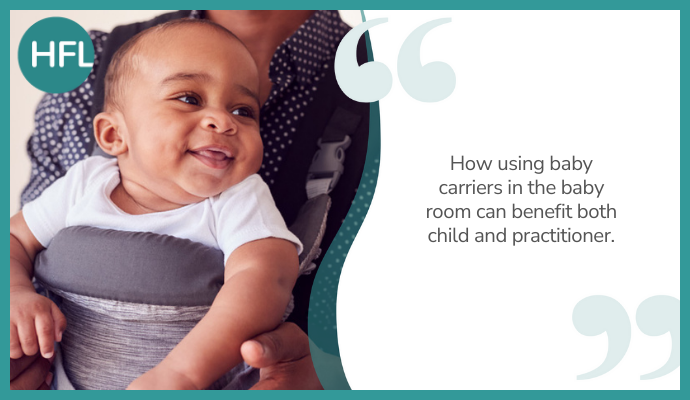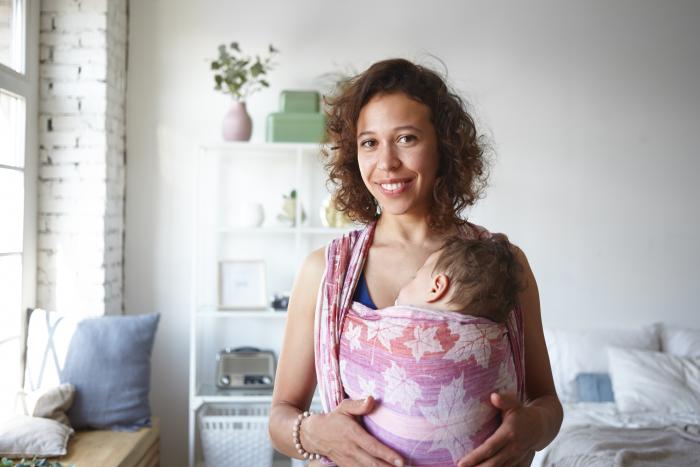
Let’s face it, working in a baby room means that you could really do with 5 pairs of hands, especially with the varying ages and therefore differing physical abilities of the children in your care. Over the years, practitioners have become increasingly skilled at splitting their time with key children and keeping those plates spinning as they move between activities, care routines, sleep times, outdoor time and settling children. But what if I told you, there could be a way to free up your hands? Something that parents with multiple children have been doing for years. I want to talk to you about babywearing in early years settings.
Yes, you read that right – wearing babies! It’s well documented how beneficial it is for parents to use baby carriers, slings, or fabrics to hold their infants close to their bodies and it has been practiced all around the world for thousands of years. The skin-to-skin contact makes for regulating a child’s body temperature, heartrate and breathing as well as developing muscle tone needed for sitting, crawling, and walking. As well huge benefits for the baby, the parent can keep the child close, safe and have hands free, which is especially useful if there is more than one child in the household. Therefore, in a setting where the ratio is 1 practitioner to 3 children, it seems obvious that using a carrier to hold a child has its benefits.
But before you jump onto Amazon to order one, let’s break this down.
Informing parents and the correct carrier
In the same way that you inform the parents about the activities you provide, if you are bringing in babywearing to your practice, ensure that you inform the parents this is something that you do.
In the U.K, using baby carriers is a relatively common practice but you will have some parents who have never used one, or have a specific type of carrier they would want you to use due to the needs of their child.
Some children may absolutely despise being carried, therefore there is no point in trying to get them into the carrier to calm them down if this would do the exact opposite and make them even more destressed. This is where your communication and relationships with primary carers are key. Do they have a carrier they would specifically like you to use? Think about whether you are happy for them to provide this, in the same way that they might provide a comforter or sleep bag.
When looking to purchase a carrier, ensure that it is:
- easily washable
- quickly adjustable for different practitioners’ bodies
- quickly to adjustable for different children
- suitable for the age/weight of the children in your care
- from a reputable company that promotes safe babywearing
It would also be best practice to check with your managers and health and safety representative that they are happy for you to go ahead.
Practitioner health and wellbeing
We know that most practitioners will do anything to give the children in their care the best opportunities possible, however this should not be to the detriment of their health. Some practitioners may not feel physically comfortable or able to carry children in this way, and that must be respected. It could also come with a mental load that some practitioners do not feel comfortable to bear, and this to, must be respected. When ordering a carrier, discuss as a team what you think would work best for the children in your care. You might be able to borrow some from a local sling library to try out or even from parents. Once the decision has been made, ensure that all the practitioners who will be using the carrier feel confident in doing so.
Appropriate use
Children often come to settings because their parents wish for them to experience all the different opportunities that early year’s educators offer. Babywearing should not be used in a way that takes children away from these opportunities. Instead, the introduction of this should be to enhance professional love, build bonds and help children feel secure.
For example, think about a baby who is cutting their first tooth and wants to be held by their key person as this is where they feel calm and safe. Using a carrier would benefit the child in this instance in addition to the practitioner and the other children, as they are able to play and attend to others needs whilst the teething baby is tucked up safely in the carrier.
Imagine a wet and windy day. Most of the children in the baby room can toddle around the outdoors, but the youngest baby does not have any wet weather clothes and is unable to crawl yet. A practitioner could ‘world face’ this little one in the carrier so they can feel the breeze, taste the air, and experience the elements, whilst safely and warmly against the body of their trusted key person. Note: children must be at least 4 months old to face outwards.
Safety
The U.K Sling Consortium have published advise on what to consider when using a baby carrier and have come up with the helpful acronym T.I.C.K.S
T – Tight. Carriers must be tight enough to hold the child close to you.
I – In view. A child must be within your view by just glancing down.
C – Close enough to kiss. The child should be as close to your chin as possible and you should be able to tip your head forward and kiss their head.
K – Keep chin of chest. A baby should never be curled so their chin is forced onto their chest as this can restrict their breathing. Ensure there is always a space of at least a finger width under the baby’s chin.
S – Supported back. In an upright carrier a baby should be held comfortably close to the wearer so their back is supported in its natural position and their tummy and chest are against you.
The full poster can be found here:
Are you ready to give it a go?
My experience of babywearing in a setting was only positive. The practitioners were able to care for and soothe babies who were tired, teething, unsettled or just needed some extra love. It wasn’t something that was used constantly, but we had our carrier there for when it was needed – and believe me, sometimes it was needed! We had such positive feedback from the parents as they could see that we were using strategies that they would as parents, and this enhanced our relationships with them and their children. Professional love is key when caring for children in the early years and particularly so for the infants in our settings and I truly believe that babywearing is a way to build and promote this connection.
I’d love to know if you give this a go in your setting, or if you would like any further advise, please feel free to contact me.
If working with under twos is a passion of yours, then watch out for our “Baby Room in Action” course coming up in the spring term.




